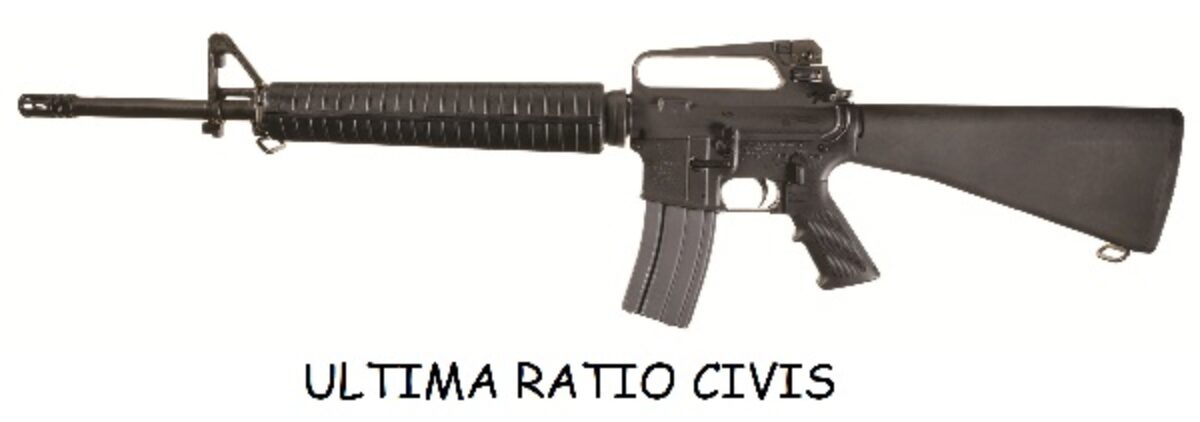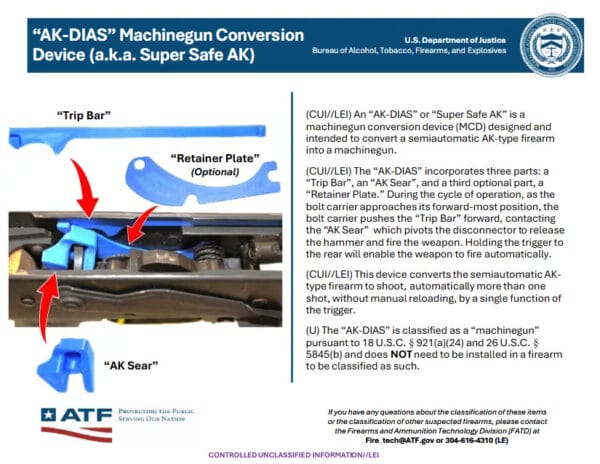
Category: Gun Schtuff
This is the way it’s been in Europe for quite a while. Major parts of a gun are serialized, and restricted. You can see this on Glocks and other European made guns where the serial number is on the frame, slide and barrel. Just like for ammo, if the tyrant demoncraps in California do happen to pass such a crap-for-brains law, people who are interested enough will simply cross the state line to buy.
Beyond ‘Ghost Guns’: California Democrats Push Background Checks for Gun Barrels
California Democrats are pushing legislation to require background checks for gun barrel purchases, effectively taking the “ghost gun” regulatory push to its logical conclusion.
The bill, Senate Bill 704, is sponsored by state Sen. Jesse Arreguín (D).
SB 704 singles out firearm barrels among the many other parts of firearm, requiring a background check for any replacement barrel or aftermarket barrel upgrade purchase:
Commencing on July 1, 2026, this bill would, except as specified, prohibit the sale or transfer of a firearm barrel, as defined, unless the transaction is completed in person by a licensed firearms dealer. The bill would require the licensed firearms dealer to conduct a background check of the purchaser or transferee and to record specified information pertaining to the transaction, including the date of the sale or transfer.
Moreover, SB 704 specifically outlines how the costs of performing background checks for barrels must be handled, making clear that the legislation literally creates “a new crime,” albeit a misdemeanor, in the state California.
Gun rights proponents have long warned that the Democrats’ use of terminology like “ghost guns”–and the resulting regulation of said “guns”–would lead to background checks for aftermarket firearm parts. State Sen. Arreguín’s legislation is doing just that.
Additionally, the National Association for Gun Rights (NAGR) warns that with a background check, SB 704 would end online barrel sales via the requirement for face-to-face transactions.
NAGR said, “We have warned that this was always the end goal. Target the secondary market — driving up the cost of repairing and maintaining firearms in an effort to win through attrition. The ultimate objective is a complete ban on online sales.”
Decision, decisions…………
IWI Drops New Mafteah “Other” Firearm
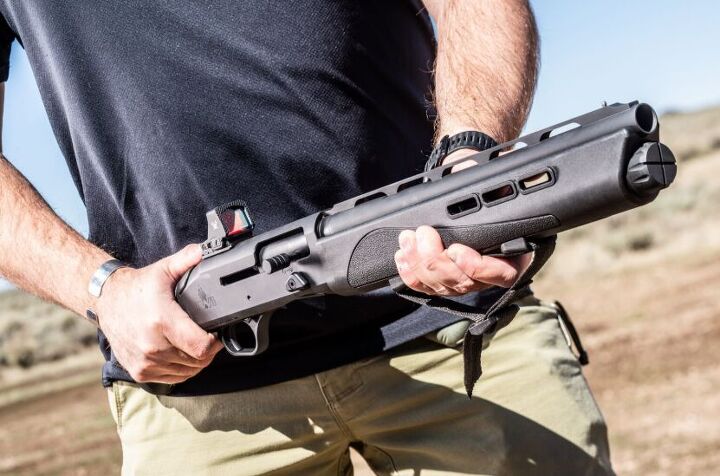
IWI is getting in on the “other” firearm game with the new Mafteah. This semi-auto 12-gauge, 3-inch gun features a 14-inch smoothbore barrel and pistol grip, making it an “other” firearm under US law instead of a short barrel shotgun or any other weapon, either of which would be subject to NFA regulation. This new gun is named for the “ Key of Solomon” textbook of magic, which I had to look up because I had never heard of it.
The Mafteah features a drilled and tapped receiver for optics mounting and features a pocket for direct-mounting red dot optics. Three MLOK slots sit on each side of the handguard for accessory mounting, and a strap on the bottom of the handguard keeps the support hand from drifting in front of the muzzle during firing. The gun is recoil operated, with a spring that surrounds the magazine tube operating the bolt. That magazine tube holds five 2 ¾” shells or four 3” shells if you want a heftier payload. A vent rib with a bead front sight runs down the top of the barrel.
The MSRP for the Mafteah is $999.
From the manufacturer:
“It is said the Key of Solomon could do almost anything, contain anything or anyone, and open any passageway one might need. This one isn’t quite so magical, but it will do a number on opening doors. The MAFTEAH Shotgun is a semi-automatic auto loading, shotgun, 12Ga 3’’, with 14 inch barrel. It functions based on a recoil operated system that utilizes a recoil spring around the magazine tube. This allows the shotgun to be very compact and reliable.”
SiG 320s have been having “uncommanded” discharges, and we get this?
Glad to know the “carry without it chambered” fuddlore just got another decade of life breathed into it. pic.twitter.com/yiijSZGA6O
— Shadz (@Shadzey1) April 23, 2025
I had been of a mind to SBR a Remington TAC-14, but they went bankrupt before any gun store in town ever had one in stock to take a look at.
Well…….
Are SIG P320 Discharges Really About the Gun… or Just Overloaded Duty Rigs?
Another day, another headline dragging the SIG P320 through the mud. This time, it’s the Washington State Criminal Justice Training Commission banning the P320 from its academy due to concerns over accidental discharges. Recruits who were issued the striker-fired SIG are now being handed loaner guns for firearms training.
Unless you’ve been living under a rock—or purposefully tuned out the noise—you’ve probably seen the P320 lawsuits, user complaints, and media blitzes. Considering the P320 is the U.S. military’s standard sidearm and one of the top-selling pistols in the country, controversy was inevitable.
But is it really about the gun? Or are we ignoring something bigger?
Holster Mishap or Firearm Flaw?
Seattle’s KING-5 News recently covered an incident involving a sheriff’s deputy responding to a call involving an emotionally disturbed individual. During the takedown, a round discharged from the deputy’s holstered P320. No injuries, fortunately.
But here’s where it gets weird: the agency claimed the discharge was caused by a loose handcuff arm getting into the trigger guard while still holstered.
You read that right.
The holster in question was fitted for a weapon-mounted light, which inherently adds bulk and leaves a wider opening. That extra room between the gun and the holster mouth? It’s an invitation. Whether it’s a cuff arm, zipper pull, drawstring, or even a suspect’s finger during a scuffle, you’ve now got a clear path to the trigger.
We’re not looking at a design defect. We’re looking at a setup fail.
First Look: Smith & Wesson 10mm M&P FPC: Add a little oomph to your folding carbine.
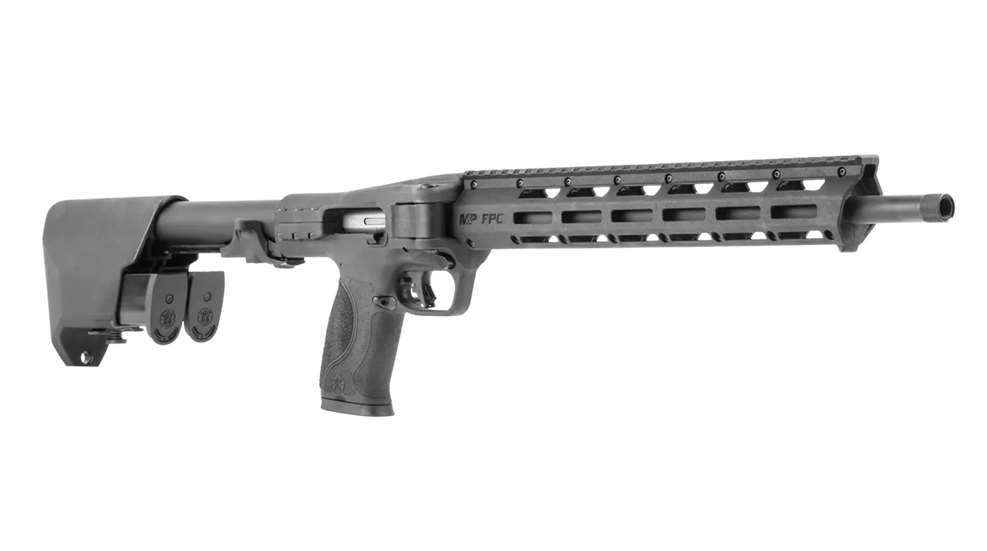
Smith & Wesson is releasing its M&P FPC now chambered in 10mm. The optics-ready FPC, or Folding Pistol Carbine, uses a blowback design and is equipped with three 15-round double-stack M&P M2.0 pistol magazines. It features an integrated recoil buffer system, an overall length of 30.6 inches and can fold to 16.5 inches long for easy storage. The horizontal folding mechanism of the FPC provides a locking latch to ensure secure transport and prevents interference with most top-mounted optics or accessories. Its 9/16×24 tpi threaded muzzle can be paired with the user’s preferred suppressor, while the in-stock magazine storage facilitates fast and efficient reloading.
The M&P FPC handguard features an upper Picatinny rail for mounting an optic and M-Lok slots for adding other accessories. There is a flat-face trigger with a crisp break, and the interchangeable grip inserts let you tailor the gun for more comfort. The rifle includes a carrying bag with multiple storage compartments to keep components and accessories organized and secure. In addition to the new standard 10mm model, Smith & Wesson now also offers a compliant version that shares the same feature set but includes three 10-round magazines.
Smith & Wesson M&P FPC 10mm Specifications
- Width: 2.5 inches
- Length (Unfolded) 30.6 inches
- Height: 8 inches
- Weight: 5 pounds, 11 ounces
- Caliber: 10mm
- Capacity: 15 rounds (10-round versions available)
- Action: Blowback
- Barrel Length: 16.25 inches
- Grip: Polymer
- Sights: None
- Safety: Cross-Bolt
- Color/Finish: Black
- Threaded Barrel: Yes
- Barrel Material: 4140 CM
- Frame: Aluminum
- Number Of Magazines: Three
MSRP for the M&P FPC 10mm is $499, and for more information on this rifle or other products from Smith & Wesson, visit smith-wesson.com.
Senate Bill 3: Gun licensing scheme much broader than claimed
The Colorado legislature is close to final passage of Senate Bill 25-003, to impose one of the most restrictive licensing systems in the nation on many, but not all firearms. Legislators and the public should understand that the bill would apply to all semiautomatic centerfire handguns. The kinds of handguns that Coloradans typically choose—from companies such as Glock, Ruger, or Smith & Wesson—would become much more onerous to purchase.
Senate Bill 3 seems cunningly written. It purports to apply only to the “gas-operated semiautomatic handgun.” (p. 4). The bill then provides five types of gas operation. Cumulatively, the definitions cover almost every centerfire semiautomatic handgun.
The bill does not apply to semiautomatics that fire the puny .22 rimfire cartridge.
There is only one centerfire semiautomatic handgun model that does not fall within the bill’s definitions. That unique item is the Benelli B-80, a collector’s item last manufactured in 1990. The identical gun was produced in six different calibers, model numbers 76 through 82.
As for every other model of semiautomatic pistol, Coloradans will be forced to navigate their way through one of the most onerous systems in the nation, far exceeding even California’s.
What Happens if DOJ Stops Defending Silencer Regs?
Now that Attorney General Pam Bondi has signaled the Justice Department is re-evaluating its stance that silencers aren’t “firearms” protected by the Second Amendment, what happens if the DOJ reverses course and suddenly declines to defend their inclusion in the National Firearms Act?
We wouldn’t suddenly see suppressors available for sale with a simple NICS check, unfortunately. That would require changing the NFA itself, which in turn would require congressional approval. The House may very well give its approval to the SHUSH Act, but it’s gonna be tough to get 60 senators on board with the change. So what impact would a DOJ reversal have in practical terms?
The NFA has been a flashpoint for advocates, who say that silencers are not frequently used in crime and believe that the silencers and other weapons regulated under the law, including machine guns and short-barreled rifles and shotguns, are protected by the Second Amendment. A decision by the Justice Department not to defend the law may, however, make it harder for gun rights groups to challenge the law at the Supreme Court.
“If Trump administration decides not to prosecute people under for illegal silencer possession while in office, that’s a good short-term win, that’s what a lot of gun rights activists will want,” said Stephen Gutowski, a gun safety instructor and founder of The Reload.
However, Gutowski added that if Democrats regain the White House in four years, “They can just reverse the policies and go back and start prosecuting people again, because the law was never found unconstitutional or invalid.”
If the Trump administration just decides not to enforce the NFA regulations surrounding suppressors, I don’t think that would actually be much of a win for gun owners, though it might provide some short term benefit for suppressor buyers and the companies that make them. What would stop the next Democratic administration from zealously prosecuting those companies or anyone who purchased/possesses a suppressor not registered or taxed under the NFA?
The best option may be for the Trump administration to decline to defend the current statute and not raising any objections to anti-gun AGs intervening as defendants in ongoing litigation. Then the full weight of the DOJ could be directed to side with the plaintiffs in these lawsuits, while allowing the cases to continue to make their way to SCOTUS.
Gun safety groups, for their part, say that silencers put people at risk by make a mass shooting harder to hear and contend that because silencers reduce the recoil when a gun is fired, it could make it easier for a gunman with a semiautomatic to shoot with fewer interruptions.
“Silencers in the wrong hands create serious public safety risks,” Everytown for Gun Safety writes on their website. “The loud and distinctive noise that a gun makes is one of its most important safety features: when people hear it, they realize they may need to run, hide, or protect others.”
The group also raises concerns that removing silencers from the NFA would allow them to be purchased without a background check.
Frankly, if suppressors aren’t “firearms” as the DOJ (and at least one federal court contends), then they arguably shouldn’t be included in the National Firearms Act as a restricted firearm. And yes, their removal from the NFA could allow their purchase without a background check, but if they’re merely an accessory then so what? What other firearm accessory requires a background check of any kind, much less a detailed check and an extra $200 tax?
Of course, whether there are five justices on the Supreme Court at the moment who are ready to remove suppressors from the NFA is very much an open question, especially after Wednesday’s 7-2 decision upholding the ATF’s rule treating unfinished frames and receivers as completed firearms. The bottom line is even if the Trump administration is on board with the idea, deregulating suppressors is going to be a challenge, whether it’s through the legislative or judicial branches.
On March 11, 1963, US Defense Secretary Robert MacNamara ordered the adoption of the M16 rifle by the US military. Designed by Eugene Stoner, it was a scaled down and improved version of his 7.62 NATO chambered AR-10
Leave guns to the professionals
In December of 2024, in Secret Service Secret Marksmanship, I took to task the unnamed Secret Service Agent who fired at least six shots at the second Trump wannabe assassin from a distance of only a few feet and missed every shot. One would think Secret Service agents on a presidential detail would be better shots. One would apparently think wrongly. One would also think they’d be better shots than the average local patrolman. In that case at least, one would also think wrongly.
One of the articles of faith and narratives of anti-liberty/gun cracktivists is the police are highly trained marksmen. We must leave guns to them because Normal Americans aren’t so highly trained and will just shoot themselves, their families and worse, they might shoot criminals. The truth is quite different.
Putting on the blue suit and a badge does not bestow upon police officers magical shooting abilities beyond the abilities of citizens. Only a small portion of any police force are gun guys and girls. Most police officers have only a single gun: their agency-issued handgun. The only training they get comes from their basic academy—private or public—and whatever refresher training their agency provides. Periodic qualification doesn’t count. Unless a given officer spends the time and money in regular practice and in advanced, private training, that’s all they’ll ever have.
For most agencies, qualification is a once-a-year burden. Ammo is expensive, and so is taking officers off the street. They have to be replaced by other cops at overtime rates. Qualifications normally fire no more than 50 rounds at never-changing stationary targets at known ranges, usually no greater than 25 yards, and commonly no greater than 15 yards. Often, strings of fire aren’t timed, and only 70% proficiency is the usual standard. Officers pass if they miss only 30% of their shots.
Even better, officers are allowed to reshoot the course of fire as many times as necessary to pass. Were that not true, were officers required to be 70% proficient on demand, far too many would fail, which means they’d be desked until they could meet that standard, or fired, which is much too expensive.
Don’t ask how often officers clean their handguns, whether they’ve been trained to do it or have the proper equipment.
Keep in mind large blue city police agencies tend to have even lower standards. Their executives are politicians who have to reflect their boss’s beliefs if they want to keep their jobs. That means they don’t like guns, don’t like cops and trust neither. They’re not going to do what’s necessary to ensure officers have a high degree of shooting ability. Two examples illustrate reality:
The New York City Police Department issues guns with 12-pound trigger pulls. Standard Glocks have 5.5 pound triggers. The heavier the trigger, the harder it is to shoot accurately. NYPD brass are worried about negligent discharges, so they issue hard to shoot guns. The results are predictable:
In 1990, NYPD officer hit potential was only 19%. That means 81% of the rounds they fired at criminals missed. At less than three yards, they hit only 38% of the time. From 3-7 yards, 11.5% and from 7-15 yards, only 9.4%
Some of those less than 3-yard shots were at muzzle-touching range. There are many cases on record of police officers emptying their guns at crooks at inside-a-phone-booth range and missing every shot. Those 1990 results haven’t improved with time. Heavy triggers combined with poor training have inevitable consequences. We now move to Los Angeles, setting for innumerable police dramas where sharp shooting cops never miss.
In 2013 LAPD Officer Christopher Dorner, a large black man, was fired for cause and began hunting superiors he thought responsible. He was reportedly driving a pickup truck. Eight LAPD officers, including a supervisor, were covering the home of a LAPD Captain, a potential Dorner target, when a blue pickup entered the neighborhood. Those eight officers unleashed 103 rounds at the truck, which did not contain Dorner but two Hispanic women delivering newspapers.
This was a classic example of “me too!” police shooting. One officer shoots at something and every nearby officer, having no idea why they’re shooting, joins the fun.
Fortunately, their marksmanship was reliably poor. They hit the truck, seven nearby homes and nine other vehicles. The women were only wounded. They were awarded $4.3 million, and none of the officers were disciplined.
I’m not denigrating the police. I used to be one. They do a difficult job that requires they always be right amazingly well. But shooting is a perishable skill. Unless one learns the right techniques and regularly practices and improves, they’ll fail under stress. Many citizens spend that necessary time and money. Most cops don’t.
As with politicians we get the police, and police marksmanship, we deserve.
Triple-Shock X Ammo: TSX Bullets Explained
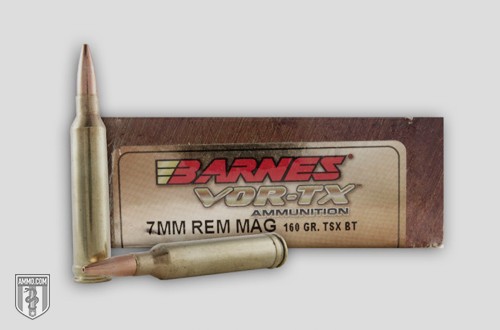
The Triple-Shock X is Barnes Bullets’ premium hunting rifle ammunition. Commonly referred to as Barnes X bullets, this line of ammo comes in most rifle calibers, and the bullet is quite unique in that it uses a fairly thin diameter hollow section in the tip compared to similar styles. The thin section works extremely well to create a uniform expansion effect when it impacts a target.
Another thing that makes this and related Barnes ammo lines unique, is they don’t have a bullet core. You’re firing solid copper with the TSX, and it works better than you’d imagine, especially if you’ve used cored bullets or solid lead for years. This bullet type came out in 2004, and has been popular among hunters, rifle shooters and reloaders ever since.
Triple-Shock X Features
- Lead-Free: Like many specialty lines from Barnes Bullets, the TSX ammo line is lead-free. This is a perk if the area you’re hunting in doesn’t allow lead bullets. This bullet is usable everywhere lead is banned, but may be considered a hollow point in most areas (but not all).
- Solid Copper: The solid copper bullet offers great weight retention, and it maintains its structural integrity much better than a lead or jacketed bullet. This means you will get better weight retention and deeper penetration than with other bullets that will fragment to a much greater degree than the solid copper.
- Circumferential Grooves: These grooves are what make the copper bullets from Barnes perform so well in regards to barrel fouling. They are the product of years of research to keep copper as a viable bullet material.
- Thin-Diameter Hollow Point: The hollow point in the Triple-Shock X is narrow compared to similar brands, but with the copper bullet, it works just right. Each shot will expand into four razor sharp cutting edges on impact, unless a hard object like bone is encountered.
Triple-Shock X Uses
This is a great rifle ammunition developed for hunting. The sheer number of calibers offered is impressive, ranging from .224 caliber to the .577 Nitro. If it can be hunted, Barnes makes a Triple-Shock bullet for the job.
This wouldn’t be a very good home defense ammunition, however, unless you had significant distance between you and would-be attackers. These bullets were designed to travel long distances with relatively flat trajectories and to devastate their target on impact.
The Triple-Shock X is one of the more premium ammo lines by this particular manufacturer, and if you’re looking for a lead-free alternative hunting ammunition, this is a very popular choice with great reviews. The one bullet style that rivals this from Barnes is the Tipped Triple-Shock X.
Colorado – The U.S. Forest Service (USFS) has finalized a sweeping ban on dispersed recreational shooting – where forest visitors set up targets and practice shooting in an undesignated, undeveloped location – across 73% of the 1.1 million-acre Pike National Forest, a move that has drawn significant opposition from Second Amendment advocates.
The decision, part of the agency’s Integrated Management of Target Shooting Project, aims to address what officials call “unacceptable risks to public safety” as the forest sees increased use from hikers, cyclists, and off-roaders.
Under the new policy, over 800,000 acres will be off-limits to dispersed target shooting, while six designated shooting ranges will be developed with noise abatement features and safety measures. The closures will be implemented in phases, with areas near Rampart Range Road, previously subject to emergency orders, among the first to be restricted. The agency insists that the plan balances public safety, resource management, and recreational shooting opportunities.
“This decision marks the transition from one era of recreational shooting into the next,” said Douglas County Board of Commissioners Chair George Teal, who supports the ban.
The move has also been praised by the Southern Shooting Partnership, a coalition of government and utility agencies that have worked for years to address shooting-related conflicts in the region.
However, gun rights advocates argue that the ban is a clear violation of the Second Amendment.
The Mountain States Legal Foundation’s Center to Keep and Bear Arms has filed an official objection, challenging the Forest Service’s authority to restrict firearms-related activities on such a massive scale.
“By restricting the people’s right to engage in dispersed target shooting within the Pike National Forest, the USFS is attempting to regulate arms-bearing conduct in violation of the Second Amendment to the United States Constitution,” the foundation’s objection states.
Franklin Armory and FRAC Defeat ATF, Judge Rules Words Mean Things.
The U.S. District Court in North Dakota today issued its opinion in the Firearms Regulatory Accountability Coalition (“FRAC”)-Franklin Armory firearms classification-related lawsuit against ATF. In his ruling, Judge Daniel M. Traynor vacated the ATF’s prior misclassifications of Franklin Armory’s Reformation and Antithesis firearms. Judge Traynor’s ruling solidifies what the firearms industry has known for years—that the ATF has been abusing its firearms technology classification powers.
Per the Court’s opinion:
Franklin Armory presented a square peg, and ATF shoved it into a round hole. If Congress wanted “shotgun” to be a catch-all category for anything that doesn’t fit “rifle,” it could have done so. . . . . It is not for ATF to redefine the terms because it thinks Congress didn’t intend a certain outcome. Therefore, ATF exceeded its authority in defining “smoothbore” as anything lacking “functional rifling.”
FRAC and Franklin Armory are reviewing the Court’s ruling and seeking further guidance from legal counsel as to the future of both Reformation and Antithesis under the law. Judge Traynor’s opinion declares that the “ATF classification of the Antithesis and reclassification of the Reformation [are] VACATED.” In response to ATF’s arguments, Judge Traynor retorted that “Administrative agencies need to remember they are in the executive branch and leave legislating to Congress.”
FRAC President & CEO, Travis White, stated that “the ATF has egregiously abused the firearms technology classification process, and this is a landmark ruling in reining in such abuses.”
Franklin Armory President Jay Jacobson said, “we spent years trying to reason with ATF leadership as they failed to classify firearms correctly. We hope that future agency leaders will stick to the law as passed by Congress. All we ever wanted was a good referee, not someone to throw the game.”
Judge Traynor’s summary judgment ruling in FRAC v. Garland, No. 1:23-cv-00003, can be found here.

The built in gun lock that nobody wanted.
Leak Shows ATF Continues to Disregard Court Orders on FRTs
In a recent Bureau of Alcohol, Tobacco, Firearms and Explosives (ATF) leak released by AmmoLand News and Gun Owners of America (GOA), the government agency shared its fears about 3D-printed machinegun conversion devices (MCD), but not everything the ATF listed is an MCD.
The ATF included the Super Safe AK in its documents, claiming it was in a drop-in auto-sear (DIAS). The issue with that designation is that the Super Safety is not a machinegun or an MCD. It is a forced reset trigger (FRT), and the Bureau might be violating a court order by designating the device as a machinegun in its January 15, 2025, documentation.
Each time a shooter uses the AK Super Safe, they must pull the trigger. The statute definition of a machinegun is a firearm that expels more than one round per function of the trigger. For each function of the trigger, the Super Safety only expels a single round. It does not fit the definition of a machinegun as defined under the National Firearms Act of 1934 (NFA). The Supreme Court has already ruled that the ATF cannot change the statutory definition of a machinegun in the Cargill case.
The Cargill case involved a bump stock. SCOTUS found that since a shooter must pull the trigger between each round, a bump stock is not a machinegun. The Cargill case has been referenced in NAGR v. Garland, which challenged the ATF’s definition of FRTs as machineguns. In that case, the judge found that only one round is expelled per trigger function. The judge issued an injunction against the ATF from taking enforcement actions against the owners and manufacturers of FRTs. Yet, the ATF is still informing law enforcement agencies that FRTs are machineguns.
The ATF also refers to the AK Super Safe as the AK-DIAS. The AK-DIAS is not the same as the AK Super Safe. The AK-DIAS is a separate project and is a machinegun conversion device. It does convert a semi-automatic AK into a fully automatic firearm. The AK Super Safe engages the safety between every round making it impossible to fire automatically. It appears that the ATF is trying to conflate the two different devices which could lead to confusion amongst law enforcement, and the false arrest of Americans for possessing something that is completely legal.
This situation isn’t the first time the ATF rebelled against the courts or the White House. The ATF was criticized for disregarding an executive order demanding that diversity, equity, and inclusion (DEI) positions be eliminated. The order explicitly stated that those employees should be placed on administrative leave, and agencies should not try to hide them. The ATF did the opposite of the order. Lisa T. Boykin was the ATF’s “Chief Diversity Officer” responsible for implementing DEI at the Bureau. After President Trump issued the order, her title was changed to “Senior Executive.”
The ATF also recently came under fire for disregarding multiple court orders blocking the pistol brace rule. In that case, the ATF told a Gun Owners of America (GOA) member that their CZ Scorpion equipped with a brace would have to be registered with the NFA division of the ATF and pay a $200 stamp fee, or they could be charged with a federal felony. The ATF said that even though the rule was blocked, they could interpret the statute however they wanted. GOA forced the issue, and the ATF finally issued a retraction.
The situation is similar in this case. Even though the courts have barred the ATF from taking action against FRTs by a permanent injunction, they seem to be doing just that. Many view the Bureau as an out-of-control rogue government agency that ignores the law and does what it wants to do. This situation doesn’t instill confidence in those running the ATF, including the default head of the Bureau, Marvin Richardson.
Some have campaigned for Richardson to become the permanent head of the ATF, but this situation is the third time in a month that the ATF has disregarded a Presidential or court order. It leads many to wonder if Richardson is complacent or incompetent.
SAAMI Announces Acceptance of New Cartridges
The Sporting Arms and Ammunition Manufacturers’ Institute ®Inc., (SAAMI®) has announced the acceptance of three new rifle cartridges for SAAMI standardization, according to The Outdoor Wire.
SAAMI is the organization at the forefront of promoting firearm safety by creating standards that ensure safety, reliability and interchangeability of firearms, ammunition and components.
Click on the cartridge name to open the introduction package.
7mm Backcountry – The 7mm Backcountry (7mm BC) was introduced by Federal Premium Ammunition (The Kinetic Group) with a 170-grain bullet traveling at a velocity of 3,000 fps and a Maximum Average Pressure of 80,000 psi.
25 Creedmoor – The 25 Creedmoor (25 CM) was introduced by Hornady Manufacturing Company with a 134-grain bullet traveling at a velocity of 2,810 fps and a Maximum Average Pressure of 62,000 psi.
338 Advanced Rifle Cartridge – The 338 Advanced Rifle Cartridge (338 ARC) was introduced by Hornady Manufacturing Company with a 175-grain bullet traveling at a velocity of 2,050 fps and a Maximum Average Pressure of 52,000 psi.
For further information on these new cartridges please visit https://saami.org/technical-information/cartridge-chamber-drawings/.

